It’s mid-June now, and unless you’re in one of those weird East Coast communities that go until the 4th of July, that probably means school’s out for summer. It was a fraught, difficult school year for people everywhere, and it’s a relief to have reached the end. Hopefully we can all regroup, recharge, and regather our wits for a better and more normal educational calendar in the fall.
But it’s not fall right now—it’s summer.
My children have been out of school for two and a half weeks now, and they’ve basically gone feral already. My daughter is living in a series of bathing suits or ballerina skirts, and sometimes both at once; my son has assembled a very impressive pile of sticks in the driveway that he’s referring to as his “museum”. This isn’t just limited to the children, mind you; my usual routines have unraveled, too.
The summer slide is real, and we’re all going down it head-first.
If we want to be in any position to act like productive members of society come September, we’re going to have to do just a little bit of educational enrichment over the summer. And you know what? There are lessons to be learned everywhere.
[everyone groaning]
Hey, now. Lessons don’t need to be boring. And you’ve all been great students this year. So let’s start with a pizza party.
7) Lesson #1: Be open to new ideas
Today’s food headliner is less a recipe than it is an idea, but it’s a damned good idea, one I must credit to my Twitter pal @twoeightnine, from whom I appropriated it.
You see, I love making pizza. It’s the perfect level of moderate kitchen project, and it’s always fun to show off a pie you’ve made completely from scratch. But no one in this house can agree on ingredients. My son likes plain cheese pizza. My daughter likes plain cheese pizza, but with less sauce. My wife likes fairly traditional pizza toppings, and I like getting wacky and/or spicy with my toppings. But four pizzas is far too much to make.
So why not break it down?

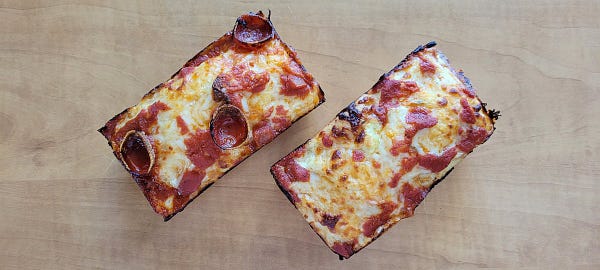

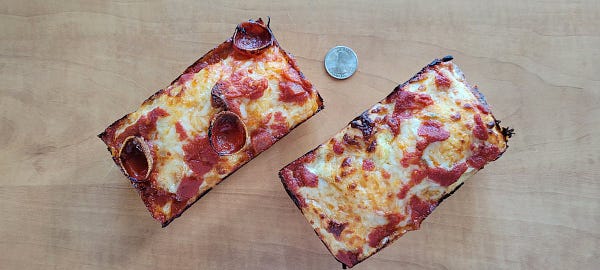
Following Matt’s lead, I purchased a set of miniature baking pans; these are the ones I used (I bought two sets, for a total of eight pans). They’re roughly the same shape and material as the pans I have for making Detroit-style pizza. Now, the best part about Detroit-style pizza is the crispy edges. The Michigan-born chain Jet’s Pizza—my favorite widespread pizza chain—boasts an “8-corner pizza” that maximizes those edges.
But if you ask me? That’s not enough corners.
We’re making a 32-corner pizza.
One normal batch of pizza dough divides just right between eight miniature pans, but allows you to customize the toppings for each one, allowing everyone to get exactly what they want.
I used a high-hydration, no-knead, overnight dough—500g of bread flour, 10g yeast, 30g olive oil, 15g salt, and 300-340g of water, mixed until just shaggy but still wet, covered in plastic wrap and allowed to proof overnight at room temperature. Punch down and ball several times during the course of the proofing, and an hour or so before baking, divide the dough into eight pieces and stretch into the eight oiled pans and cover again. The dough will retract a bit, but should relax in the final hour and allow you to spread it to the edges.
Top as you see fit, though I’ll note Marcella Hazan’s famous tomato sauce recipe works beautifully as a pizza sauce, too.
Bake at 500-550F for 12-15 minutes, or until the edges are nice and crispy.
Why make one pizza, when you can make eight?
But Scott, I don’t have miniature baking pans.
Well, I’ve got just the thing for you.
7B) IT’S ACTION COOKBOX TIME AGAIN
Want to try this recipe? I’ll send you these exact same pans (not the actual same ones; a clean, new set of the same product), and a bunch of other things!
If you’ve been around here a little while, you know I’ve been doing a monthly-ish reader appreciation program to do a drawing for what I call The Action CookBox, a grab bag of fun stuff that I’ll mail to one lucky paying subscriber. I’ve sent out five of these boxes to date, and they seem to be a hit!
Well, guess what: I’ve got another one coming!
This month’s box includes:
(8) miniature baking pans, exactly what you need to make the recipe above
Ratio: The Simple Codes Behind the Craft of Everyday Cooking, by Michael Ruhlman; one of the most useful and interesting cookbooks I’ve ever read
Famous Men Who Never Lived by K. Chess (last week’s book recommendation)
Spherical ice molds, something I use very often in my drink-making
Secret Aardvark Habanero Hot Sauce, one of my favorite hot sauces
A package of Louisville Vegan Jerky, a fun new spin on a classic snack food
AND OF COURSE some of my very fine Action Cookbook Newsletter stickers, ideal for placing on laptops, garage fridges, coolers, pets, spouses, stop signs, whatever, and an ACBN keychain to boot.
Are you not yet a paying subscriber to the ACBN? Sign up before 6pm ET Sunday, and I’ll include you in the drawing too!
Now, back to our lesson plan.
6) Lesson #2: Know when to abandon a bad idea
I have to let you in on my cocktail-making process.
You see, almost every week for two years running here, I’ve shared a cocktail as part of the Friday slate of recommendations. Sometimes it’s a classic cocktail, or a recipe from some other, more reputable outlet. Often times, though, it’s an original creation, something I’ve brainstormed at home and found satisfying. Sometimes I wing it, and sometimes that works.
Sometimes it doesn’t.
Now, you probably could’ve told me this was a bad idea from the start, but bear with me. A couple weeks ago, I was at a store and they had grape Fanta. I love grape soda—I know it’s a divisive flavor, mostly because it tastes less like grapes and more like the color purple itself—and I became briefly preoccupied with the notion that I could make a cocktail from it.
Friends, readers, citizens of the world, let me tell you what: it was a bad idea.
What I made was not necessarily undrinkable—which is to say that I still drank it, and sort of enjoyed it—but I cannot necessarily call it a cocktail, nor can I in good faith suggest you attempt it. My final attempt was a combination of grape soda, rum, Amaro and lemon juice, and do you know what it tasted like? It tasted like grape soda.
I’m not sure what I expected.
Anyways, Lesson #2.2 is: have a backup plan, and trust the experts when in a pinch.
The New York Times recently published a recipe for a Lambrusco Spritz, and it hits all the summer drink notes I hoped my ill-fated cocktail might; bold, fizzy, flavorful and refreshing.
You should make that, and not what I originally made.
Lambrusco Spritz
1-1/2 ounces amaro or similar aperitif
1/2 ounce fresh grapefruit juice
3 ounces chilled Lambrusco
1 ounce sparkling water
grapefruit wedge and Castelvetrano olives (for garnish)
Fill a wine glass with ice, and pour the amaro, juice, Lambrusco and sparkling water over the ice; drop the olives into the drink and garnish with the grapefruit wedge.
Yes, this was much better. Make this instead.
Also, if you have any ideas for how a grape soda cocktail might actually succeed, I’m all ears.
5) Lesson #3: Be sweet to me
Here’s a record I’ve been listening to basically non-stop since it released last week: Jubilee, the third album released by multi-talented musician/author Michelle Zauner under the name Japanese Breakfast, is powerful, eclectic, joyful, sexy, nuanced and bold. It’s just a terrific pop album and is my early leader for soundtrack to the summer.
4) Lesson #4: A brief foray into natural history
I’ve had less time for actual reading lately, which has made me appreciate the pleasures of a well-narrated audiobook, something I can let play through my workday and commute. Edward Posnett’s odd, delightful non-fiction book Strange Harvests: The Hidden Histories of Seven Natural Objects fit this bill perfectly.
In seven individual-but-linked stories, Posnett sets out across the globe seeking to fill a metaphorical museum with curious items from the natural world, ones that have become prized for their rarity and special qualities—eiderdown, edible birds’ nests, civet coffee, sea silk, vicuna fiber, tagua/vegetable ivory, and guano. He chose these items not at random, but for the symbioses they represent—economies that only thrive on cooperation with the natural world, rather than pillaging and depletion of it.
It’s a fascinating listen, and the soothing British narrator makes for an excellent background educator.
3) Lesson #5: Know where this comes from
If you haven’t yet had the chance, I strongly recommend making the time for Netflix’s much-lauded recent documentary miniseries High on the Hog: How African American Cuisine Transformed America.
From Netflix’s official description:
Based on Jessica B. Harris’ award-winning book, High On The Hog traces the moving story of a people's survival and triumph via the food that has knit generations together and helped define the American kitchen. From Gumbo to fried chicken, our culinary journey stretches from Africa to enslavement, to the Harlem Renaissance, up to our present-day; we celebrate the courage, artistry, and resourcefulness of the African American people. This is not just an African American story; it’s an American story. A feast for all the senses.
In four hour-long episodes, chef and writer Stephen Satterfield traces the roots and influence of African cuisine on America, traveling to West Africa, the South Carolina Lowcountry, and more, showing the common threads of African-American food stretching back hundreds of years. It’s a thoughtful, informative food travelogue up there with the best of Anthony Bourdain, with a deep emotional core rooted in the pain and suffering of generations past.
2) Lesson #6: Make time to play
For more than nine months, I have gawked at the ambition of my friend Marc Normandin’s project RetroXP, a free newsletter on top of the excellent sports/labor newsletter that Marc also writes.
Last fall, Marc—an avid gamer—set out to rank the 100 greatest Nintendo games of all time, writing a full, insightful review of each one. This week, finally, he reached the conclusion of this project, naming his #1 game of all time.
(You guessed it: Jim Henson’s Muppet Adventure.)
Okay that’s not actually what he picked but you have to give him the click to find out.
1) The Final Lesson: find a warm spot and lay in it
We’re rounding out our weekend prep here as we always do, with a selection of the finest animal friends you have to offer. And once again I am asking you: please send me more photos! I have somehow managed to exhaust my supply again, and there’s few things I love more than getting your pets in my inbox.
Nevertheless! On to this week’s furry friends.
First up this week, Michael F. shares a Hall of Fame pup:
Scott, just wanted to thank you again for everything you do on the newsletter, and thanks for the recent book giveaway! I got An Arsonist’s Guide to Writers’ Homes in New England, and upon opening it found that the book jacket was on backwards, which seemed appropriate!
As a token of my appreciation here’s a pic of my dog. I got him in April of last year when the pandemic first started, and it’d be hard to imagine life without him. I thought he was a lab, but a recent DNA test informed me he is a chow-chow, American Bulldog, Amstaff Terrier, Husky mix. He’s named Yadi, after future hall of fame catcher Yadier Molina. His favorite things include eating, fetch, walks and looking more comfortable than I’ll ever be. Thanks again!
Ahhh what a good boy. I bet he has strong feelings on enforcing the unwritten rules of fetch, like “don’t pretend you’re throwing the ball only to not throw it” and “seriously, just throw the ball”. Great dog.
Next up, Jake P. shares a pair who feel the same way I’ve felt all week:
Here's some more pictures of my Pitbull Jerry and my dad's Wheaten Terrier mix Ticket waiting for the rain to stop so we can go outside.
Look at these good boys! You go outside right now and tell the rain to cut the crap. There are dogs waiting! (Great dogs.)
Finally this week, I want to send you off with a very Big Mood from my good friend Elizabeth, whose handsome gentleman dog Bogey is a key romantic interest/frequent harassment victim of my dear Holly:
Snoozy summertime vibes.
May we all one day experience even a fraction of this level of chill. Good boy. I’m sorry my dog loves you so aggressively.
Thank you to each of you for sharing, and thank you as always to all of you for your ongoing support of The Action Cookbook Newsletter. I hope you have a terrific weekend.
—Scott Hines (@actioncookbook)



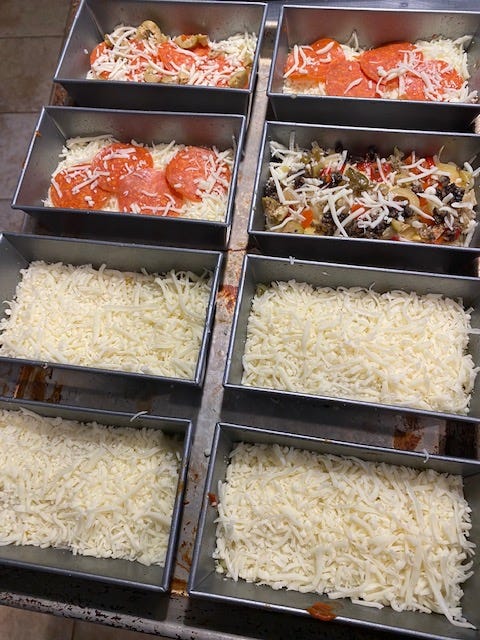
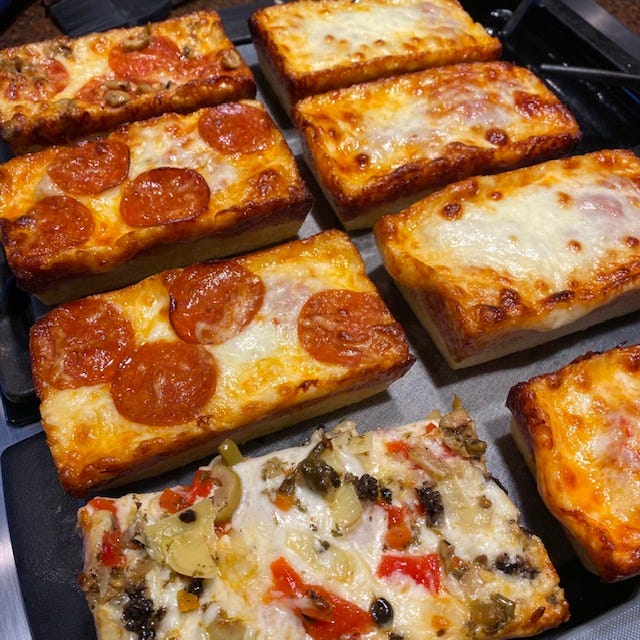



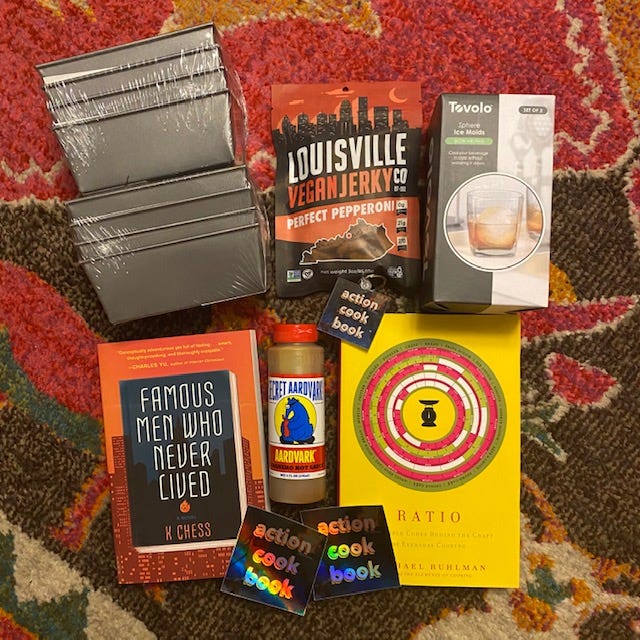
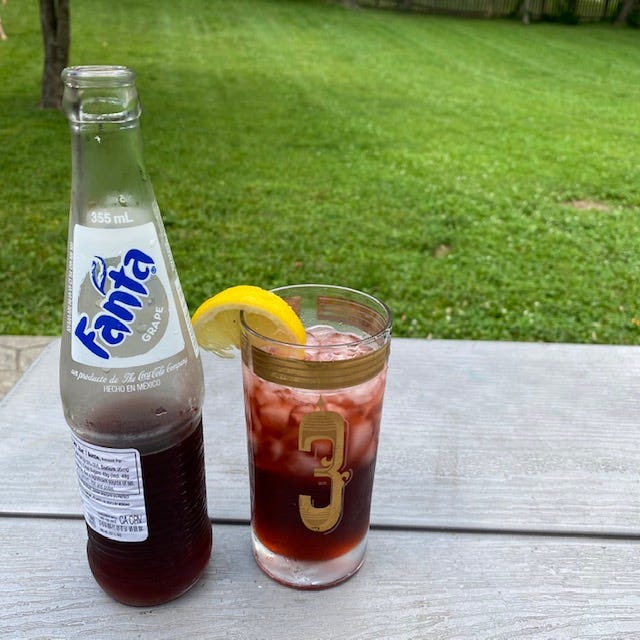
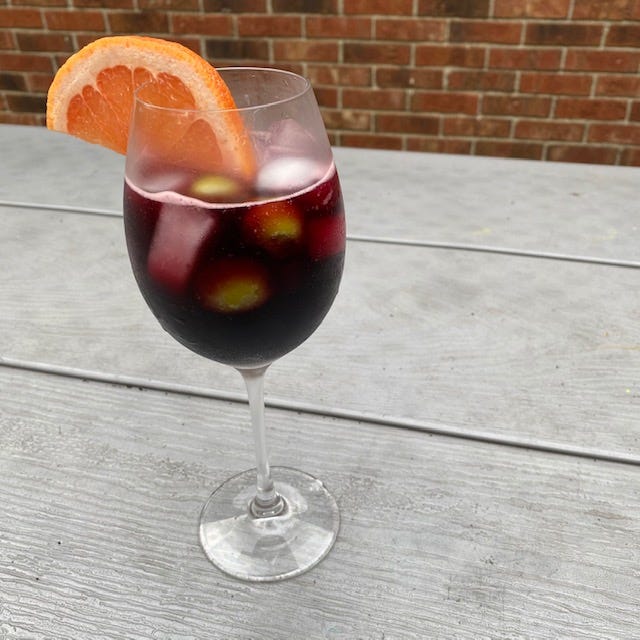
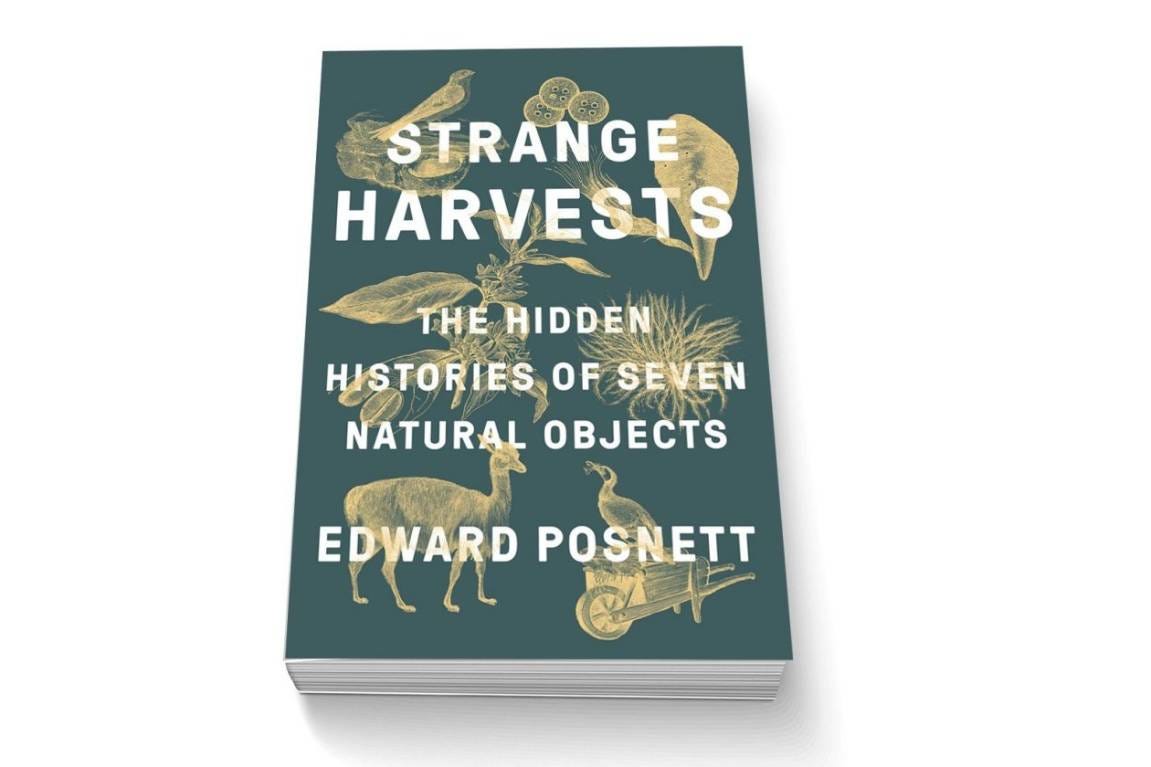




My thoughts for grape soda cocktails:
1. Use it like fizzy, sweet, wine in a float situation for something like a New York Sour, with the thought that the limited amount of soda compared to the larger amount of strongly flavored rest-of-cocktail will allow for better balance. (If you want to go completely ridiculous, celebrate Queen Victoria's favorite beverage of Scotch and Claret, and make the New York Sour with scotch instead of rye.)
2. In one of the cocktail books we have, someone boils down Coke into a syrup, and uses that strongly-flavored syrup in a cocktail. Maybe you could do that with grape soda? (No, I don't remember which cocktail book this is, because I have too many.)
Also, not saying there's a corgi puppy coming to the Plaid house in July, but I will say dog pictures are in your future, since you're asking nicely.
The grape soda cocktail reminds of two things in the young and stupid part of my life:
1. Grape soda was my favorite thing to drink after smoking <redacted> in college. Just perfect for the occasion. I can pretty much taste it just reading about it.
2. During Beach Week after my senior year of high school, I had the brilliant idea to mix vodka with grape gatorade. My teenage brain reasoned that the grape flavor would mask the vodka flavor well, the electrolytes would make my body absorb the alcohol faster, and I would prevent dehydration. I had a great time until I had a really bad time. The really bad time lasted much longer than the great time.